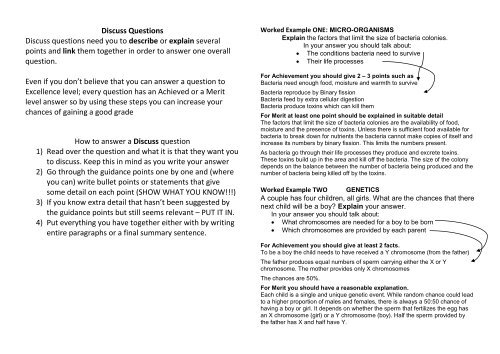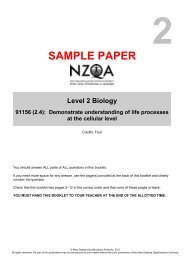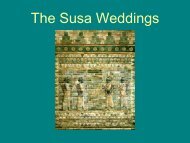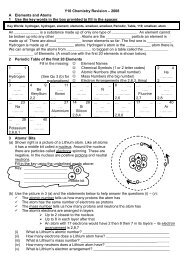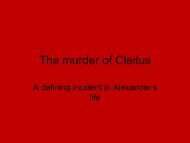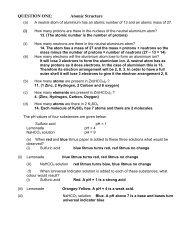How to Answer Discuss Questions
How to Answer Discuss Questions
How to Answer Discuss Questions
Create successful ePaper yourself
Turn your PDF publications into a flip-book with our unique Google optimized e-Paper software.
<strong>Discuss</strong> <strong>Questions</strong><br />
<strong>Discuss</strong> questions need you <strong>to</strong> describe or explain several<br />
points and link them <strong>to</strong>gether in order <strong>to</strong> answer one overall<br />
question.<br />
Even if you don’t believe that you can answer a question <strong>to</strong><br />
Excellence level; every question has an Achieved or a Merit<br />
level answer so by using these steps you can increase your<br />
chances of gaining a good grade<br />
<strong>How</strong> <strong>to</strong> answer a <strong>Discuss</strong> question<br />
1) Read over the question and what it is that they want you<br />
<strong>to</strong> discuss. Keep this in mind as you write your answer<br />
2) Go through the guidance points one by one and (where<br />
you can) write bullet points or statements that give<br />
some detail on each point (SHOW WHAT YOU KNOW!!!)<br />
3) If you know extra detail that hasn’t been suggested by<br />
the guidance points but still seems relevant – PUT IT IN.<br />
4) Put everything you have <strong>to</strong>gether either with by writing<br />
entire paragraphs or a final summary sentence.<br />
Worked Example ONE: MICRO-ORGANISMS<br />
Explain the fac<strong>to</strong>rs that limit the size of bacteria colonies.<br />
In your answer you should talk about:<br />
The conditions bacteria need <strong>to</strong> survive<br />
Their life processes<br />
For Achievement you should give 2 – 3 points such as<br />
Bacteria need enough food, moisture and warmth <strong>to</strong> survive<br />
Bacteria reproduce by Binary fission<br />
Bacteria feed by extra cellular digestion<br />
Bacteria produce <strong>to</strong>xins which can kill them<br />
For Merit at least one point should be explained in suitable detail<br />
The fac<strong>to</strong>rs that limit the size of bacteria colonies are the availability of food,<br />
moisture and the presence of <strong>to</strong>xins. Unless there is sufficient food available for<br />
bacteria <strong>to</strong> break down for nutrients the bacteria cannot make copies of itself and<br />
increase its numbers by binary fission. This limits the numbers present.<br />
As bacteria go through their life processes they produce and excrete <strong>to</strong>xins.<br />
These <strong>to</strong>xins build up in the area and kill off the bacteria. The size of the colony<br />
depends on the balance between the number of bacteria being produced and the<br />
number of bacteria being killed off by the <strong>to</strong>xins.<br />
Worked Example TWO GENETICS<br />
A couple has four children, all girls. What are the chances that there<br />
next child will be a boy? Explain your answer.<br />
In your answer you should talk about:<br />
What chromosomes are needed for a boy <strong>to</strong> be born<br />
Which chromosomes are provided by each parent<br />
For Achievement you should give at least 2 facts.<br />
To be a boy the child needs <strong>to</strong> have received a Y chromosome (from the father)<br />
The father produces equal numbers of sperm carrying either the X or Y<br />
chromosome. The mother provides only X chromosomes<br />
The chances are 50%.<br />
For Merit you should have a reasonable explanation.<br />
Each child is a single and unique genetic event. While random chance could lead<br />
<strong>to</strong> a higher proportion of males and females, there is always a 50:50 chance of<br />
having a boy or girl. It depends on whether the sperm that fertilizes the egg has<br />
an X chromosome (girl) or a Y chromosome (boy). Half the sperm provided by<br />
the father has X and half have Y.
Worked Example THREE GENETICS<br />
Facial dimples are a dominant genetic trait, caused by shortened facial<br />
muscles which pull on the overlying skin when a person smiles. The<br />
recessive trait produces longer muscles, so no dimples appear. D =<br />
dimples, d = no dimples.<br />
A married couple, both with dimples, have four children. One child has<br />
dimples, the other three do not.<br />
(a)<br />
(b)<br />
Give the genotypes for both parents, and explain why you chose<br />
this answer.<br />
The parents are surprised that only one of their children has<br />
dimples like they do, and wonder what they will get if they have<br />
another baby.<br />
<strong>Discuss</strong> how the process of meiosis functions <strong>to</strong> produce children<br />
both with dimples and without. Include why the parents are<br />
surprised and state the likely outcome if another child was born.<br />
Include a punnett square in your answer. Diagram/s may be<br />
used.<br />
(a) For Achievement your answer should have the correct genotypes (a)<br />
Dd or heterozygous (Allow other letters if clearly heterozygous)<br />
For Merit your answer should explain why the genotypes must be Dd (m)<br />
Eg:<br />
Both parents have the dominant trait (dimples) so can be DD or Dd. (or parents<br />
can’t be dd or would have no dimples)<br />
They must both be Dd so they can produce a dd child with no dimples / each<br />
provide a d allele <strong>to</strong> produce a child with dd genotype (no dimples)<br />
(b) For Achievement your answer should have TWO correct statements<br />
OR ONE statement AND the punnet square. Eg:<br />
Description / diagram of meiosis (a)<br />
Variation in meiosis can be caused by crossing over / shuffling/ independent<br />
assortment (a)<br />
D d<br />
D DD Dd<br />
d Dd dd<br />
Defines 2 of allele (different versions of a gene), phenotype (physical/observed<br />
trait), gene (length of DNA coding for a trait) (a)<br />
Next child has ¾ chance of dimples (a)<br />
Only 1 has dimples due <strong>to</strong> chance / each baby has same chances (a)<br />
For Merit your answer should include a correct punnet square AND<br />
explanation of outcomes of meiosis OR outcome related <strong>to</strong> chance. (m)<br />
If you use the terms allele and gene correctly you must use them correctly.<br />
Explains meiosis process (may be annotated diagram) (m) OR<br />
Meiosis is the production of gametes / sex cells, so produces cells with half the<br />
number of chromosomes. These mix at fertilization, the dominant D will show if<br />
present (m)OR<br />
Both parents have both alleles, D and d, how these combine is random for each<br />
child / not related <strong>to</strong> previous events.<br />
Chance of dimpled child phenotype is still ¾ as in punnet even though it hasn’t<br />
shown up as often as this so far. 75% chance will only be displayed in a large<br />
sample, not necessarily in only 4 children (m)<br />
AND<br />
Correct Punnett square. (as above)<br />
For Excellence your answer should discuss how meiosis produces can be<br />
produced AND links the outcome <strong>to</strong> the statistical probability of it<br />
happening. MUST include punnet square. (e)<br />
Because both parents are heterozygous, they carry both dominant and recessive<br />
alleles for the gene. In meiosis, the homologous pairs line up and are pulled<br />
apart, ie the alleles are separated. Each gamete receives one allele for each<br />
gene, ie 1/2 the genetic material of the parent. This combines randomly at<br />
fertilization with another gamete <strong>to</strong> give the various outcomes dd, DD and Dd.<br />
For a child <strong>to</strong> have no dimples it must inherit the recessive allele from both<br />
parents. As shown in the punnett this should statistically happen ¼ of the time,<br />
but each time is random /unrelated <strong>to</strong> previous outcomes, so it is quite possible<br />
<strong>to</strong> not get correct ratios unless a very large number of children are born.<br />
AND<br />
Correct Punnett square.<br />
(a)


